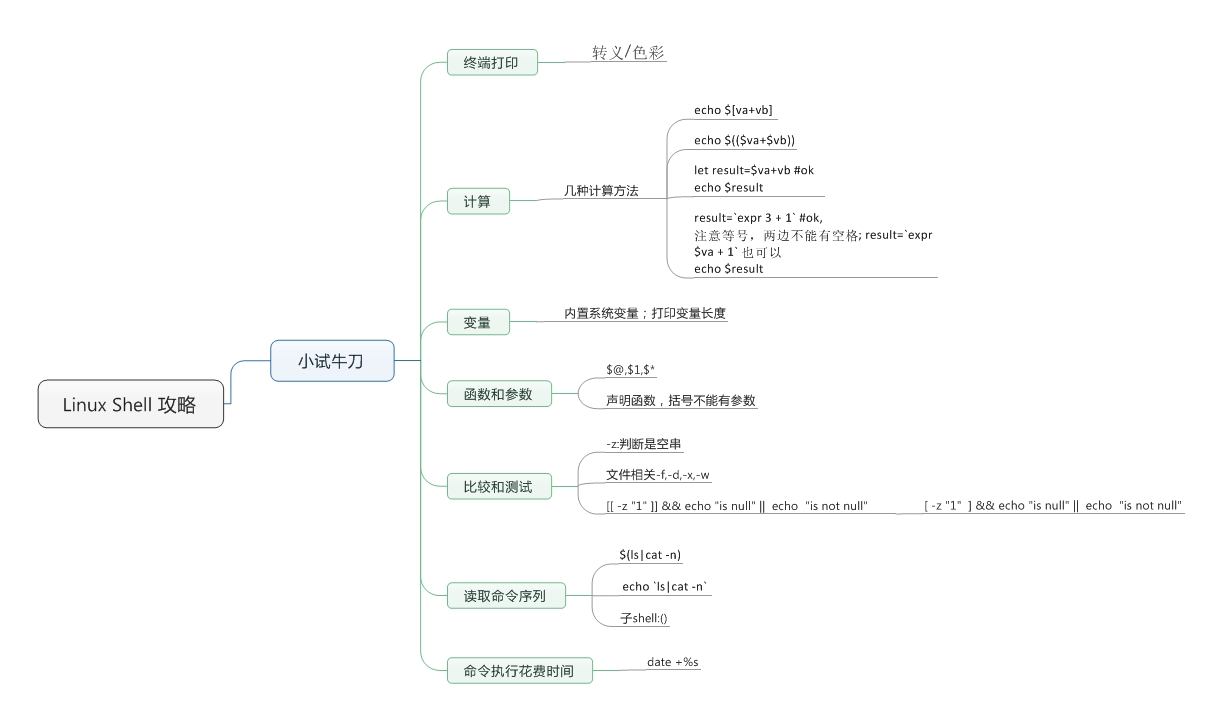思维导图学 Linux Shell攻略之小试牛刀篇
曾听一位大神讲过,带着目的去学,知识往往能记得牢,记得稳。借助思维导图这个工具,对一些我感兴趣的知识点进行分类管理。以后方便自己复习。
我会以思维导图+代码段的方式,回滚学习linux shell编程。
转义/色彩
与用户交互的接口
#打印一个普通的字符串 [root@beijing ~]# echo "it‘s isa dog" it‘s is a dog #打印一个带有单引号和换行符的字符串,单引号可正常输出,但换行符没有效果 #没有达到想要的效果 [root@beijing ~]# echo "it‘s isa dog\n this is new line" it‘s is a dog\n this is new line # -e 开启转义功能 [root@beijing ~]# echo -e "it‘sis a dog\nthis is new line" it‘s is a dog this is new line -e enable interpretation of backslash escapes [root@beijing ~]# echo it is a dog it is a dog #红字 [root@beijing ~]# echo -e "\e [1;31mthisis a color\e[0m" this is a color [root@beijing ~]# echo -e"\033[1;31mthis is a red color\033[0m" this is a red color #绿底 [root@beijing ~]# echo -e"\e[1;42mthis is a red color\e[0m" this is a red color #红字绿底 [root@beijing ~]# echo -e"\e[1;31;42mthis is a red color\e[0m" this is a red color #有效数字 echo "scale=3;3/8"|bc echo $bc
计算
这是编程语言的功能之一了
va=1; vb=2; #echo $($va+$vb);error #echo $(va+vb); error echo [$va+$vb] #output :[1+2] echo $[va+vb] #ok echo $(($va+$vb)) #//ok let result=$va+vb #ok echo $result result=`expr 3 + 1` #ok, 注意等号,两边不能有空格;result=`expr $va + 1` 也可以 echo $result result=$(expr $va + 1) #ok, 注意等号,两边不能有空格,+号必须有空格,否则会当成字符串输出 echo $result
输出变量长度
内置功能(感兴趣而已)
[root@beijing test]# exportSTR="1234"
[root@beijing test]# echo $STR
1234
[root@beijing test]# echo ${#STR}
4函数
这是最基本的,不能语句罗列吧
#括号里不能有参数,获取参数通过$1,$2....获取
function sayHello(){
echohello $1
}
#$@:参数列表
#$*:参数字符串
sayHello zgy;#这样调用读取命令序列
可得一个命令的结果
#!/bin/bash COMMANDS=ls|cat -n echo $COMMANDS #输出为空 COMMANDS=$(ls|cat -n) #$COMMANDS #error echo $COMMANDS #输出期望结果 echo `$COMMANDS` #error echo `ls|cat -n` #输出期望结果 反引用 ############################################### #子shell,在子shell操作,不影响主shell echo `pwd`; cd /bin echo `pwd`; # output# # /root/test # /bin echo `pwd`; (cd /bin) echo `pwd`; # output# # /root/test # /root/test
打印所用时间
评定一个算法的效率
start=$(date +%s) #start=`date +%s`,等号不能有空格,如果有空格,会被变量当成命令 for (( i = 0; i < 100000; i++ ));do echo$i >/dev/null done end=`date +%s` diff=$(($end-$start)) echo "use times(ms):"$diff echo "use times(ms):"$(($end-$start))
常用的测试
判断权限等,shell编程汇总功能常用
#[[]] 必须有空格 #是否是文件,文件是否存在 [root@beijing test]# [[ -f 1.txt ]]&& echo "1.txt is file" || echo "1.txt is notfile" 1.txt is file #是否是可执行文件 [root@beijing test]# [[ -x 1.txt ]]&& echo "1.txt can be execute" || echo "1.txt can be execute" 1.txt can be execute [root@beijing test]# [[ -x 1.txt ]]&& echo "1.txt can be execute" || echo "1.txt can‘t be execute" 1.txt can‘t be execute [root@beijing test]# chmod +x 1.txt [root@beijing test]# [[ -x 1.txt ]]&& echo "1.txt can be execute" || echo "1.txt can‘t be execute" 1.txt can be execute [root@beijing test]# #是否是目录 [root@beijing test]# [[ -d 1.txt ]]&& echo "1.txt is dir" || echo "1.txt is‘t dir" 1.txt is‘t dir [root@beijing test]# [[ -d /bin ]]&& echo "1.txt is dir" || echo "1.txt is‘t dir" 1.txt is dir #判断是空串吗? [root@beijing test]# [[ -z"1" ]] && echo "is null" || echo "is not null" is not null [root@beijing test]# [[ -z"" ]] && echo "is null" || echo "is not null" is null -z 与-n功能相反
小计
看书本,很简单的代码,也就是一看就懂的代码。其实真正自己写出来,在运行起来得到结果,也不容易。 眼高手低要不得。
我就在写程序是经常遇到一些这样情况。有时候要求有空格(比如条件判断时)。有时候不能有空格(变量赋值时)。有时候,单引号有时候又 反引号。哎要注意啊这些小细节,总结经验。
小小代码也不简单。
如果广大读者,也可以看着我的脑图,一步步写一下脚本,也会有所收获。
算个开篇吧。断断续续,随着学习深入,例子也会逐渐深入。希望自己的shell水平,能有所突破。
本文出自 “简单” 博客,请务必保留此出处http://dba10g.blog.51cto.com/764602/1607563
郑重声明:本站内容如果来自互联网及其他传播媒体,其版权均属原媒体及文章作者所有。转载目的在于传递更多信息及用于网络分享,并不代表本站赞同其观点和对其真实性负责,也不构成任何其他建议。




































